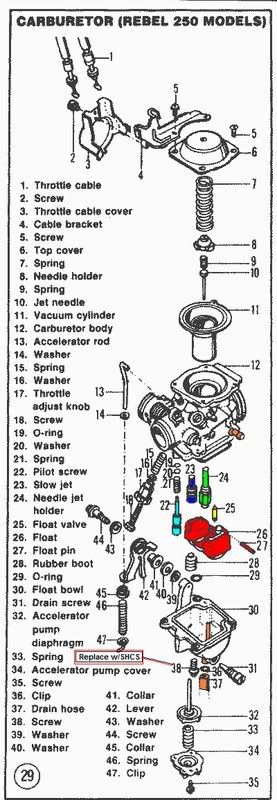Been awhile since I messed with a carb like this, but I can at least help you get this started.
More than likely you have fuel spilling from the two orange orifices. This would be indicative of the float not being set correctly or dirt clogging things up.
The carb will come off with a little work. Remove the throttle cable, and then the two clamps holding onto the breather, and the engine intake. A little finagalling and it should come out.
Once you get it out, take out the 4 screws that hold on the float bowl to the bottom of the carb. Set these aside, and plan to take them to the hardware store and switch them with Socket Head Cap Screws before you button everything back up. The original screws are Phillip head, and made from cheap materials. They will become wallowed out after a few (maybe just one) carb removals. Best to change them out first thing. Makes thing so much nicer in the future. (remember these are metric sized)
Your float (26 RED) is pivoting on a small pin (27 RED). There is a small valve on the float (25 YELLOW) that can stop the fuel from flowing into the carb if the float is set at the proper height. When you have the carb out with the bowl off, the manual will give you step by step instructions for setting the float to the proper height. This will most likely be done with the carb upside down.
While you are there, you want to clean things up real well. Any fuel left in the carb for very long can create a varnish that can clog these orifices up real easy. Sediments from the tank can also find their way to the jet holes.
Usually you can take carb cleaner and spray the whole thing out real well and this will take care of things. But you may want to actually take the jets out and make sure there are no obstructions in the (23 BLUE) and (24 GREEN) holes.
Do not soak your carb in anything, and do not leave the carb cleaner on things a long time like overnight. The solvent can attack the seals after a long time.
There will also be detailed instructions on how to set the pilot screw (22 LT BLUE). Be sure and set it properly.
The slow jet (23 BLUE) controls fuel into the cylinder at slow speeds, and if you often ride in the city with frequent stops, this being too large can create an overly rich fuel situation. There are numbers on the jet that designate size. Make sure you have the proper slow jet according to your manual. It is a safe bet that you can go down one size of the slow jet and not hurt a thing, and most likely help things a bit. This little unit has a flat slot on top and comes out easily with a screwdriver. Be gentle with them both in and out.
Be very certain that the needle jet holder (24 GREEN) is free from obstructions. It probably screws right out.
It all looks very intimidating, but is not that hard once you delve into it. Something that can be done in under an hour and will probably save you $300.

